Overexpression of a Gene Involved in Phytic Acid Biosynthesis Substantially Increases Phytic Acid and Total Phosphorus in Rice Seeds
- PMID: 27135323
- PMCID: PMC4844318
- DOI: 10.3390/plants4020196
Overexpression of a Gene Involved in Phytic Acid Biosynthesis Substantially Increases Phytic Acid and Total Phosphorus in Rice Seeds
Abstract
The manipulation of seed phosphorus is important for seedling growth and environmental P sustainability in agriculture. The mechanism of regulating P content in seed, however, is poorly understood. To study regulation of total P, we focused on phytic acid (inositol hexakisphosphate; InsP₆) biosynthesis-related genes, as InsP₆ is a major storage form of P in seeds. The rice (Oryza sativa L.) low phytic acid mutant lpa1-1 has been identified as a homolog of archael 2-phosphoglycerate kinase. The homolog might act as an inositol monophosphate kinase, which catalyzes a key step in InsP₆ biosynthesis. Overexpression of the homolog in transgenic rice resulted in a significant increase in total P content in seed, due to increases in InsP₆ and inorganic phosphates. On the other hand, overexpression of genes that catalyze the first and last steps of InsP₆ biosynthesis could not increase total P levels. From the experiments using developing seeds, it is suggested that the activation of InsP₆ biosynthesis in both very early and very late periods of seed development increases the influx of P from vegetative organs into seeds. This is the first report from a study attempting to elevate the P levels of seed through a transgenic approach.
Keywords: Oryza sativa L.; ectopic expression; mineral element; molecular breeding; phosphorus; phytic acid; seed; translocation.
Figures
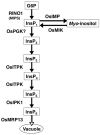
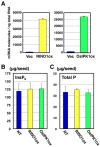
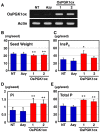
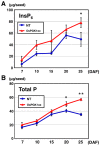
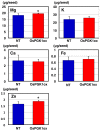

Similar articles
-
Dynamic changes in the distribution of minerals in relation to phytic acid accumulation during rice seed development.Plant Physiol. 2012 Dec;160(4):2007-14. doi: 10.1104/pp.112.206573. Epub 2012 Oct 22. Plant Physiol. 2012. PMID: 23090587 Free PMC article.
-
Development of low phytate rice by RNAi mediated seed-specific silencing of inositol 1,3,4,5,6-pentakisphosphate 2-kinase gene (IPK1).PLoS One. 2013 Jul 2;8(7):e68161. doi: 10.1371/journal.pone.0068161. Print 2013. PLoS One. 2013. PMID: 23844166 Free PMC article.
-
Novel allelic variant of Lpa1 gene associated with a significant reduction in seed phytic acid content in rice (Oryza sativa L.).PLoS One. 2019 Mar 14;14(3):e0209636. doi: 10.1371/journal.pone.0209636. eCollection 2019. PLoS One. 2019. PMID: 30870429 Free PMC article.
-
Seed Biofortification and Phytic Acid Reduction: A Conflict of Interest for the Plant?Plants (Basel). 2015 Nov 20;4(4):728-55. doi: 10.3390/plants4040728. Plants (Basel). 2015. PMID: 27135349 Free PMC article. Review.
-
Progress in breeding low phytate crops.J Nutr. 2002 Mar;132(3):503S-505S. doi: 10.1093/jn/132.3.503S. J Nutr. 2002. PMID: 11880580 Review.
Cited by
-
Mining of Potential Gene Resources for Breeding Nutritionally Improved Maize.Plants (Basel). 2022 Feb 25;11(5):627. doi: 10.3390/plants11050627. Plants (Basel). 2022. PMID: 35270097 Free PMC article. Review.
-
Genome-wide analysis of ATP binding cassette (ABC) transporters in tomato.PLoS One. 2018 Jul 26;13(7):e0200854. doi: 10.1371/journal.pone.0200854. eCollection 2018. PLoS One. 2018. PMID: 30048467 Free PMC article.
-
Seed targeted RNAi-mediated silencing of GmMIPS1 limits phytate accumulation and improves mineral bioavailability in soybean.Sci Rep. 2019 May 23;9(1):7744. doi: 10.1038/s41598-019-44255-7. Sci Rep. 2019. PMID: 31123331 Free PMC article.
-
Comparative Transcriptomics Unveil the Crucial Genes Involved in Coumarin Biosynthesis in Peucedanum praeruptorum Dunn.Front Plant Sci. 2022 May 17;13:899819. doi: 10.3389/fpls.2022.899819. eCollection 2022. Front Plant Sci. 2022. PMID: 35656010 Free PMC article.
-
Genetic Approaches for Iron and Zinc Biofortification and Arsenic Decrease in Oryza sativa L. Grains.Biol Trace Elem Res. 2022 Oct;200(10):4505-4523. doi: 10.1007/s12011-021-03018-0. Epub 2021 Nov 13. Biol Trace Elem Res. 2022. PMID: 34773578 Review.
References
-
- Raboy V. Approaches and challenges to engineering seed phytate and total phosphorus. Plant Sci. 2009;177:281–296. doi: 10.1016/j.plantsci.2009.06.012. - DOI
-
- Nadeem M., Mollier A., Morel C., Prud’homme L., Vives A., Pellerin S. Remobilization of seed phosphorus reserves and their role in attaining phosphorus autotrophy in maize (Zea mays L.) seedlings. Seed Sci. Res. 2014;24:187–194. doi: 10.1017/S0960258514000105. - DOI
-
- Ros C., Bell R.W., White P.F. Effect of seed phosphorus and soil phosphorus applications on early growth of rice (Oryza sativa L.) cv. IR66. Soil Sci. Plant Nutr. 1997;43:499–509. doi: 10.1080/00380768.1997.10414777. - DOI
-
- De Marco D.G. Effect of seed weight, and seed phosphorus and nitrogen concentration on the early growth of wheat seedlings. Aust. J. Exp. Agric. 1990;30:545–549.
LinkOut - more resources
Full Text Sources
Other Literature Sources

